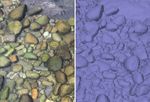DRONES IN HYDRAULICS BY HAMISH BIGGS - iAHR
←
→
Page content transcription
If your browser does not render page correctly, please read the page content below
hydrolink 1-2019v3.qxp_25462 22-02-19 13:28 Pagina 4
DRONES IN HYDRAULICS
BY HAMISH BIGGS
The rise of drones in hydraulics reflects the demand for higher resolution data at lower cost. Drones are now
affordable, reliable and easy to use, making them well suited for investigation of finer scale processes (mm to
cm), compared to the landscape scales covered by aircraft and satellites. The rise of drones has also been
paralleled by exponential improvements in lightweight sensor technology. For example, high resolution digital
cameras (>50 MP), LiDAR units and hyperspectral cameras can now be carried by consumer grade drones with
less than 5 kg of payload. This article provides an introduction to the use of drones in hydraulics and discusses
an exciting future of drone based remote sensing.
Figure 1. Drones provide a cost-effective platform for aerial surveying of waterbodies. Photograph: Dave Allen, NIWA
Drone hardware imagery and general surveying, while larger aerial imagery is determined by flight speed,
Unmanned Aerial Vehicles (UAVs), Unmanned units (such as the DJI Matrice 600 Pro) are altitude and image overlap. Camera settings,
Aerial Systems (UAS) and Remotely Piloted suitable for LiDAR and other payloads up to 5 flight speed and lighting are critical to obtain
Aircraft Systems (RPAS) are some of the many kg. good aerial imagery. Shutter priority mode is
synonyms for drones. Their forms are equally recommended, with 1/1000 shutter (or faster)
diverse, with fixed wing aircraft, miniature Aerial imagery and surveying to minimise image blur. Ground Control Points
helicopters, balloons, blimps, kites and The most common application for drones in (GCP) are used to obtain georeferenced aerial
multirotor aircraft all used for environmental hydraulics is recording aerial imagery and images. GCPs can be either targets set out
remote sensing [1]. The choice of appropriate surveying (Figure 1). The spatial resolution of and surveyed, or identifiable features with
drone hardware depends on the mission aerial imagery is determined by drone altitude known (surveyed) locations. The use of GCPs
requirements (e.g. area covered, altitude, and camera specifications. For example, the can sometimes be avoided if camera origin is
payload and flight time). The most commonly DJI Phantom 4 Pro with 20 MP sensor and 24 known with RTK or PPK GPS precision. Aerial
used drones for hydraulics applications are mm equivalent focal length lens achieves pixel images can either be analysed individually or
multirotor aircraft. Small multirotors (such as resolution of 5.5 mm at 20 m altitude and 27.5 combined into a ‘georeferenced orthomosaic’
the DJI Phantom 4 Pro) are used for aerial mm at 100 m altitude. The spatial coverage of (basically a 2D photo map) for further analysis
4 hydrolink number 1/2019hydrolink 1-2019v3.qxp_25462 22-02-19 13:28 Pagina 5
IAHR
Image analysis Hamish Biggs is a scientist at
Classification of aerial imagery can either be the National Institute of Water
performed manually [2] or using automated and Atmospheric Research
(NIWA) in New Zealand. His
techniques [3]. Which approach is appropriate
research covers novel remote
depends on the survey frequency, input data sensing techniques, flow
type, classes to be resolved and required around aquatic vegetation,
output accuracy. For one-off surveys with RGB sediment transport,
imagery, manual image classification provides biomechanics, image analysis and field equipment
development.
higher accuracy [3] and is usually faster than
using automated techniques. For automated
image classification significant time must be
spent setting up and tuning the classification Bathymetry
algorithms, then evaluating the accuracy of In the future bathymetric (green) LiDAR units
the automatic classifications against manual may reach the price, performance and weight
classifications or ground truth data. For of terrestrial (infrared) LiDAR units. When this
research applications, this is often a diversion occurs drone-based bathymetric LiDAR
from the original purpose of the survey and surveys will become common practice. Until
results in studies devoted to the accuracy of then, other means to determine bathymetry
the automatic classification rather than from remote sensing data can be used. For
detailed analysis of the survey data. example, bathymetry from: underwater
Automated techniques often struggle to imagery (Figure 3), through water imagery
separate the boundaries of overlapping or corrected for surface refraction [6], spectral
touching objects within a class. This is not a attenuation of light with depth, or turbulence
problem if only the total area of classes is metrics [7].
required, however if the dimensions of
individual objects within a class are required, Underwater imagery
then this is a big problem and manual image The SfM image processing techniques
classification should be used. Where typically used for aerial drone surveying, can
Figure 2. Drone-based survey of aquatic
vegetation (River Urie, UK) automated classification techniques excel is equally be applied to underwater camera
for routine monitoring of total class area over imagery (Figure 3). For rivers that are
large spatial extents with multispectral or sufficiently clear and deep, this enables
hyperspectral imagery [4]. Hyperspectral Remote Control (RC) boat-based surveys to
imagery has hundreds of narrow spectral resolve bathymetry, grain size distributions and
bands (compared to the 3 lumped bands of bed roughness. The bathymetry data or solid
RGB imagery). It is not easy to visualise, but is models can even be used as inputs for 2D or
well suited for supervised image classification, 3D hydraulic modelling.
object-based classification, or machine
learning approaches [3, 4]. Sediment size distributions
Imagery from drones or underwater cameras
Figure 3. Solid models of a cobbled river bed Digital Elevation Models (DEMs) (Figure 3) can be used to obtain sediment size
resolved with underwater imagery from an Accurate DEMs are critical for many hydraulic distributions [8, 9]. The smallest size fraction that
amphibious drone (e.g. RC boat)
applications (e.g. erosion, hydraulic these techniques are suitable for depends on
modelling, sediment transport and the spatial resolution of the imagery. For
(Figure 2). Georeferenced orthomosaics can be morphodynamics). High resolution DEMs can braided gravel bed rivers with predominantly
easily generated with Structure from Motion be obtained from drone-based aerial imagery coarse sediment, low altitude drone-based
(SfM) software such as Agisoft Photoscan or or light weight terrestrial LiDAR units (such as surveying is a convenient way to map
Pix4D. Imagery for this purpose should have those from LiDAR USA). DEMs from aerial sediment size distributions over large spatial
60-80% overlap on all sides and at least 8 imagery are obtained using Structure from extents. This data has many applications, such
GCPs distributed throughout the site. Further Motion (SfM) image processing software (e.g. as physical habitat mapping, roughness
analysis of georeferenced orthomosaics often Agisoft Photoscan or Pix4D). For most terrain coefficients for hydraulic modelling, or inputs
entails image segmentation into classes, then types the DEMs obtained using SfM have for sediment transport modelling.
measurement of the total area of classes; or similar accuracy to LiDAR, but much lower
measurement of the number, area and dimen- equipment cost [5]. In terrain that is heavily Discharge gauging and Large Scale
sions of objects within a class [2]. Common vegetated or lacks distinct visual distinct Particle Image Velocimetry (LSPIV)
applications in hydraulics are to delineate the features (e.g. uniform mud, sand, or snow) Discharge gauging from imagery is useful for
boundaries of waterbodies, structures and biota LiDAR provides more accurate and reliable flow conditions where in-water measurement
(e.g. vegetation), then evaluate the total surface data. equipment cannot be deployed (e.g. flash
area and geometry of objects within each class. floods and debris flows) or in remote locations
hydrolink number 1/2019 5hydrolink 1-2019v3.qxp_25462 22-02-19 13:28 Pagina 6
without access to standard gauging The future? References
[1] Klemas, V. (2015). Coastal and environmental remote sensing
equipment [10]. Imagery can be recorded from In such a diverse and rapidly evolving field, it from unmanned aerial vehicles: An overview. Journal of Coastal
Research, 31(5), 1260-1267.
river banks or drones, then LSPIV techniques is challenging to speculate about the future. [2] Biggs, H., Nikora, V., Gibbins, C., Fraser, S., Papadopoulos, K.,
Green, D. & Hicks, D.M. (2018). Coupling Unmanned Aerial
used to determine surface velocities. However, there are a number of technologies Vehicle (UAV) and hydraulic surveys to study the geometry and
spatial distribution of aquatic macrophytes. Journal of
Discharge is estimated from surface velocities, and capabilities to watch. The first is the Ecohydraulics, 3(1), 45-58.
[3] Husson, E., Ecke, F. & Reese, H. (2016). Comparison of manual
bathymetry and a conversion from surface performance (and cost) of thermal infrared mapping and automated object-based image analysis of non-
submerged aquatic vegetation from very-high-resolution UAS
velocity to depth averaged velocity (such as cameras. Rapid improvements in both spatial images. Remote Sensing, 8(9), 724
[4] Parsons, M., Bratanov, D., Gaston, K. & Gonzalez, F. (2018).
the index velocity method). Bathymetry can resolution (number of pixels) and thermal UAVs, Hyperspectral Remote Sensing, and Machine Learning
Revolutionizing Reef Monitoring. Sensors, 18(7), 2026.
be surveyed independently or estimated from resolution (temperature graduation) will lead to [5] Fonstad, M., Dietrich, J., Courville, B., Jensen, J. & Carbonneau,
P. (2013). Topographic structure from motion: a new development
imagery derived data (e.g. turbulence many exciting applications in hydraulics. For in photogrammetric measurement. Earth Surface Processes and
Landforms, 38(4), 421-430.
metrics) [7]. Imagery from drones has example: studying turbulence and mixing [6] Dietrich, J. (2017). Bathymetric Structure from Motion: extracting
shallow stream bathymetry from multi view stereo photogram-
advantages over bank-based imagery in processes at river confluences, identifying metry. Earth Surface Processes and Landforms, 42(2), 355-364.
[7] Detert, M., Johnson, E. & Weitbrecht, V. (2017). Proof of concept
orthorectification and spatial coverage. zones of ground water upwelling in rivers, for low cost and non contact synoptic airborne river flow
measurements. International journal of remote sensing, 38(8-10),
For example, spatial distributions of surface studying the breakdown of thermal 2780-2807.
[8] Buscombe, D. (2013). Transferable wavelet method for grain size
velocities for physical habitat mapping, and stratification in waterbodies as surface layers distribution from images of sediment surfaces and thin sections,
and other natural granular patterns. Sedimentology, 60(7), 1709-
discharge gauging in large rivers where bank- cool, studying mixing processes due to wind 1732.
[9] Detert, M. & Weitbrecht, V. (2013). User guide to gravelometric
based imagery is not feasible. The ‘Drone loading, using subtle water temperature image analysis by BASEGRAIN. In: Advances in River Sediment
Research, Proceedings of the 12th International Symposium on
flow’ project in New Zealand is currently differences as tracers for LSPIV, and discharge River Sedimentation ISRS 2013, (pp. 1789-1796). Kyoto, Japan.
CRC Press.
developing a drone based LSPIV system gauging at river confluences. The development [10] Le Coz, J., Jodeau, M., Hauet, A., Marchand, B. & Le
Boursicaud, R. (2014). Image-based velocity and discharge
featuring a stereoscopic camera system, high of high performance aerial surveying systems measurements in field and laboratory river engineering studies
using the free Fudaa-LSPIV software. In: Proceedings of the inter-
resolution IMU (for camera orientation) and (such as ‘Drone flow’) also promise an exciting national conference on fluvial hydraulics, River Flow 2014 (pp.
1961–1967). Lausanne, Switzerland. CRC Press.
RTK GPS (for camera origin) that will avoid the future for drones in hydraulics by providing
need for Ground Control Points (GCPs) and input data for hydraulic modeling, fish
significantly improve drone based hydraulic passage, discharge gauging and physical
measurements. habitat assessments. n
Figure 4. Dr David Plew commences a surveying mission in Kaikoura, New Zealand. Photograph: Jochen Bind, NIWA
6 hydrolink number 1/2019You can also read






















































